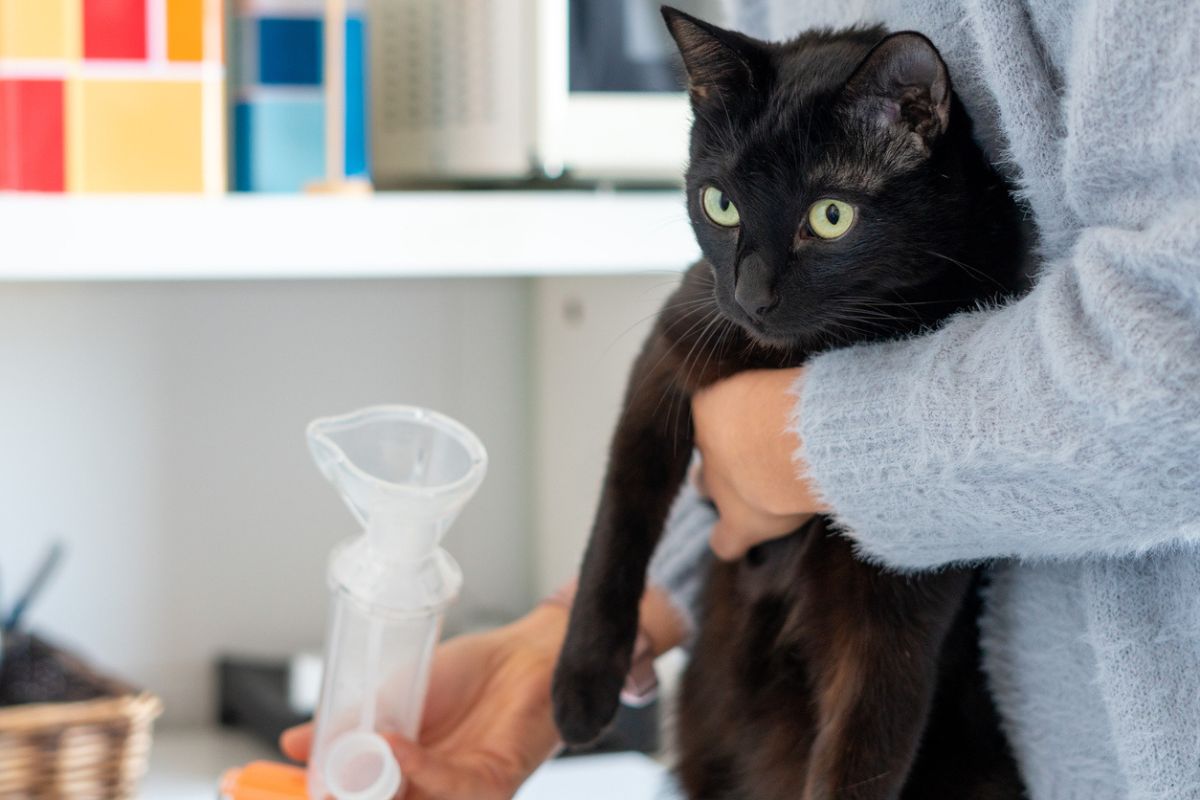Think only dogs pant? Think again. If your cat’s wheezing, puffing or open-mouth breathing, it could be feline asthma. Read on to find what causes it, how it’s diagnosed and what to do in an attack.
If you’ve ever seen a child struggling to breathe and reaching for an inhaler, you’ll know that asthma is very serious. Cats, too, can be diagnosed with asthma, and just like humans, it’s a condition they’ll live with for the long term. While cats aren’t carrying around inhalers to help them breathe more easily, you may be given a device to open up your cat’s airways.
Thankfully, cat asthma is rarely fatal, but it can be very severe, says vet Dr Nick Emerton, General Manager for Clinical Excellence at VetPartners.
“It’s not dissimilar to asthma in people,” he explains. “There are generally some sort of allergenic triggers that result in an inappropriate inflammatory response in the airways, that causes the respiratory system to have difficulty breathing.”
It’s estimated that between 1% and 5% of cats are affected by feline asthma. Dogs can also get asthma, although it’s more common for cats.
What causes cat asthma?
Cat asthma happens when your moggy’s airways become inflamed, which causes them to narrow, making breathing hard work. No one really knows exactly what causes cat asthma, but environmental causes like dust and pollen are thought to be triggers in some cases. Even overexertion during physical activity can sometimes trigger asthma symptoms. But playing amateur detective on your cat’s breathing problems won’t get you very far, Dr Emerton says.
“It’s very difficult to separate the cat from the trigger, and oftentimes it’s difficult, if not impossible, to actually identify what that trigger is,” he says.
There are, however, some known risk factors for cat asthma:
- Breed –Some evidence shows Siamese cats might be more susceptible to asthma
- Being overweight
- Having dental disease – bacteria may travel from the mouth to the airways.
What are the signs of cat asthma?
The signs of cat asthma include:
- Coughing – especially while squatting or hunched over, with their neck close to the ground. It’s not the same type of coughing cats do when they’re trying to cough up a hairball (where they usually arch their back and might walk backwards).
- Having difficulty breathing, especially if they’re breathing loudly or rapidly.
- Panting or wheezing.
- Abnormal gum colour – especially white, grey, blue or purple (if you notice this, see your vet pronto).
Like humans, cats can also have asthma attacks. As well as coughing, signs of an asthma attack include open-mouthed breathing, a rapidly moving chest and weakness or collapse. Usually an asthma attack in cats can be managed at home, Dr Emerton says.
“Sometimes there may be the need for rapid vet intervention – injections of cortisone and so forth – for cats that are having a particularly bad episode.”
How is cat asthma diagnosed?
Cat asthma can mimic other conditions, so your vet will need to rule out other illnesses that affect breathing before they make a diagnosis.
Tests to diagnose cat asthma include:
- Blood and urine tests – to check for markers of other illnesses and any allergic response.
- Faecal tests – to rule out parasites and heartworm.
- Throat examination – done under sedation, to look at the inflammation more closely.
- X-ray of the chest.
- CT scan of the lungs.
- Bronchoscopy – while the cat is sedated, a camera on a thin rod is inserted into their airways to look for signs of asthma.
- Bronchoalveolar lavage – under sedation, a thin flexible catheter goes into the lungs or throat, pushing fluid into the area then quickly suctioning it out. This is done to extract mucus and cells for testing.
How is cat asthma treated?
While there isn’t a cure for cat asthma, there are treatments to reduce inflammation in your cat’s airways and support their breathing. Your cat might be given corticosteroids (by injection or orally), or bronchodilators to open the airways – especially during an asthma attack.
“Instead of using a puffer, there’s a spacer that fits over the cat’s nose and mouth, and you give them a squirt of Ventolin, and let the cat breathe that in,” explains Dr Emerton. “That can be effective in some cats, particularly with acute episodes.”
Your vet might also give you advice about lifestyle changes to help your cat manage their asthma in the long term, including losing weight (if needed), adopting a low-allergen diet and reducing triggers (more on that below). Acupuncture, too, can sometimes be helpful for treating cats with asthma.
How do I look after a cat with asthma?
Helping eliminate potential asthma triggers from your home can sometimes help keep your cat’s airways clear. These include:
- Smoke – avoid smoking in the house and avoid using a fireplace to heat your home.
- Perfumes and sprays – such as air fresheners, candles, oil diffusers and hair sprays.
- Heavily perfumed cleaning products – including disinfectants, fabric softeners and laundry powder.
- Dust and dust mites, including dust from cat litter.
- Pollen.
- Mould spores.
“Using air filters in your home and managing a level of hygiene to decrease mould spores and dust mites can certainly help, but cat asthma is a very difficult condition to avoid or prevent,” adds Dr Emerton.
Chatting to your vet can help you find the best strategies for supporting your cat with asthma.


